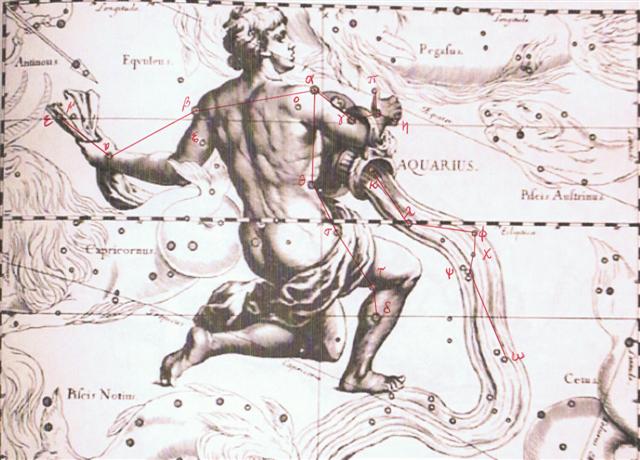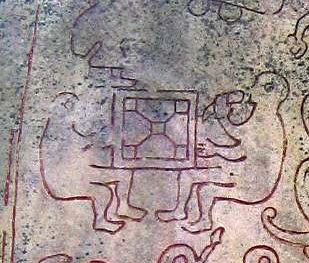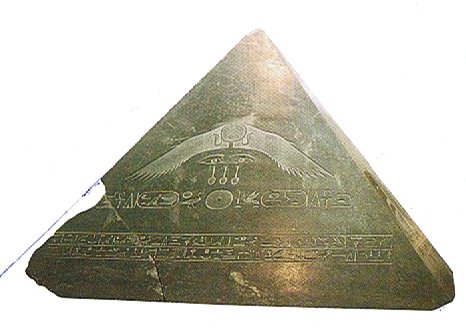Once again. The Knot (Ukdah) could have indicated this was where there should be a knot marking an end (Tarf) on a string measuring out successive days: ... Among the Nahyssan of S. Carolina time was measured and a rude chronology arranged by means of strings of leather with knots of various colour, like the Peruvian quipos. The Dakota use a circle as the symbol of time, a smaller one for a year and a larger one for a longer period: the circles are arranged in rows, thus: OOO or O-O-O. The Pima of Arizona make use of a tally. The year-mark is a deep notch across the stick ...
Heliacal Alphard was in the first of these 4 days, knotted to the tip of the mast of Argo Navis:
High up was also Vega which culminated in day 3 of these 4 Ukdah (ι Hydrae, the star straight above Alphard) days. At the other side of the year Sirius would have culminated as the center of the 5 Foundation 'Stones'. Bunda was the star ξ at the left biceps (2-headed) muscle (mouse) of Aquarius, and Sadalsud (β) was rising with the Sun 2 days earlier, in February 9:
The Southern Head of the Lion (Ras el Aset Australis, ε Leonis at Rishu A.) rose with the Sun immediately after the quartet of Ukdah days. Whereas at the opposite side of the year and close to the Full Moon would have been the last of the 5 Foundations Stones, viz. the Tail of the Goat (Deneb Algiedi, δ) - which once upon a time may have confirmed in the night that the Sun had again won a game at the Table:
... The rediscovery of the pieces of the game lying around in the grass, already told in the Völuspa, becomes clearer if one thinks of the Rigveda, where the gods themselves are said to go around like aya, that is, casts of dice. It becomes more understandable still when one considers that the name of the Indian world-ages (Yuga) has been taken from the idiom of dicing. But both data could be dismissed as unrevealing were it forgotten that in several kinds of 'proto-chess' - to use an expression by J. Needham - board games and dicing were combined: the number of eyes thrown by the dice determined the figure which was to be moved. That this very rule was also valid for tafl, the board game mentioned in the Völuspa, has been shown by A. G. van Hamel. Thus, the dice forced the hand of the chess player - a game called 'planetary battles' by the Indians, and in 16th century Europe still termed 'Celestial War, or Astrologer's Game', whereas the Chinese chessboard shows the Milky Way dividing the two camps...
... On February 9 the Chorti Ah K'in, 'diviners', begin the agricultural year. Both the 260-day cycle and the solar year are used in setting dates for religious and agricultural ceremonies, especially when those rituals fall at the same time in both calendars. The ceremony begins when the diviners go to a sacred spring where they choose five stones with the proper shape and color. These stones will mark the five positions of the sacred cosmogram created by the ritual. When the stones are brought back to the ceremonial house, two diviners start the ritual by placing the stones on a table in a careful pattern that reproduces the schematic of the universe. At the same time, helpers under the table replace last year's diagram with the new one. They believe that by placing the cosmic diagram under the base of God at the center of the world they demonstrate that God dominates the universe. The priests place the stones in a very particular order. First the stone that corresponds to the sun in the eastern, sunrise position of summer solstice is set down; then the stone corresponding to the western, sunset position of the same solstice. This is followed by stones representing the western, sunset position of the winter solstice, then its eastern, sunrise position. Together these four stones form a square. They sit at the four corners of the square just as we saw in the Creation story from the Classic period and in the Popol Vuh. Finally, the center stone is placed to form the ancient five-point sign modern researchers called the quincunx ...
|
|||||||||||||||||||||||||||||||||||||||||||||||||||||||||||||||||||||||||||||||||||||||||||||||||||||||||||||||||||||||||||||||||||||||||||||||||||||||||||








